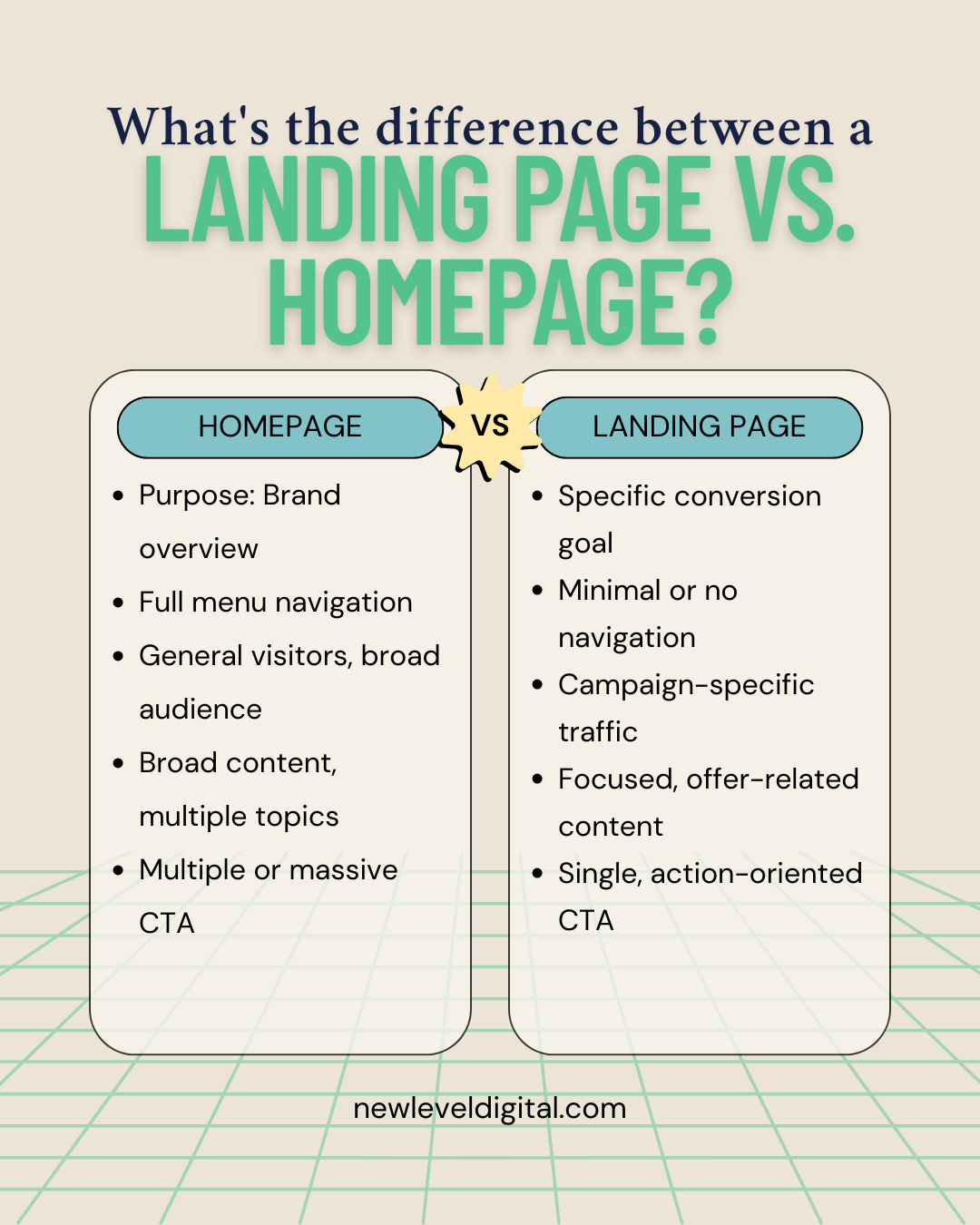Landing Page vs. Homepage: What’s the Difference and When to Use Each
Not all web pages are created equal—especially when it comes to turning visitors into leads.
If you're investing in digital marketing, it's important to understand the difference between a landing page vs. a homepage. And the difference isn't just a matter of design—it's a matter of strategy.
Many business owners blur the lines between the two, but using the right page at the right time can dramatically improve your conversion rates. When you understand the key difference between landing pages and homepages, you can integrate both for the optimal marketing strategy.
What Is a Homepage?
A homepage is the main entry point of your website; think of it as your business’s digital front door.
It's typically designed to capture organic traffic—to introduce visitors to your brand and guide them to other areas of your website. While it can include conversion elements, it's not always optimized for that specific purpose.
✔️ Key strength: Great for brand awareness and general browsing
However, homepages often include many distractions, making them less effective for driving a specific action.
Structure of a Homepage
A well-designed homepage introduces your brand, builds trust, and encourages visitors to explore your site further. It serves as the central hub of your website and sets the tone for your entire online presence.
So, what does a homepage look like? Here are the key elements of a strong homepage:
Navigation menu: Helps users find what they're looking for quickly via a navigation bar and search bar.
Overview of services or products: Gives a snapshot of what you offer.
About section: Builds credibility with a quick intro to your company.
Testimonials or social proof: Reinforces trust with real feedback.
Blog posts or resource links: Drives traffic to valuable content.
Clear contact options: Contact forms and social media icons make it easy for visitors to reach out.
Many homepages also include hero images or videos, lead-in headlines, and soft action buttons like "Learn More" or "Explore Services."
Remember, your homepage doesn’t need to do everything—its job is to create a great first impression and guide visitors toward deeper engagement.
📌 When to Use a Homepage
A homepage is a good fit when:
Visitors find you via organic search from search engines
Someone is researching your brand
Users want to explore services and company background
✔️ First impressions
✔️ Trust-building
✔️ Browsing multiple offerings
🚫 Paid ad traffic or targeted campaigns
Example: New Level Digital’s homepage is designed to introduce our services, brand story, and results-driven approach to visitors. It highlights our digital marketing services, helps users explore our portfolio, read client testimonials, and get in touch. Our homepage allows potential clients to get to know us at a glance.
What Is a Landing Page?
A landing page is a focused advertising campaign page designed with one purpose: conversion.
Each marketing campaign has a dedicated landing page. And, unlike a homepage, a landing page is intentionally stripped down.
It's meant to guide the target audience toward a single action—whether that's filling out a form, signing up, or making a purchase. Having a single action for your visitors keeps your message center stage.
✔️ Key strength: High conversion optimization potential
Landing pages reduce friction and eliminate distractions, keeping the target audience focused on one message and one next step.
Structure of a Landing Page
A high-converting landing page is designed with simplicity and focus in mind. Unlike a homepage, it eliminates distractions to guide potential customers toward one clear goal.
Persuasive elements of an effective landing page include:
Strong, benefit-driven headline: Grabs attention and communicates the main value.
One clear call-to-action (CTA): Directs users to take the next step—like signing up or making a purchase.
No navigation bar or external links: Keeps users focused on the action without wandering.
Messaging aligned with a specific offer or marketing campaign: Ensures consistency with the ad or email that brought them there.
Testimonials or guarantees: Trust builders reduce hesitation and build credibility.
Compelling visuals: Product images, icons, or short videos reinforce the message and drive engagement.
The single goal of every element on the page is to convert visitors into customers.
Whether you're collecting leads, promoting a special offer, or driving sign-ups, your landing page should be laser-focused on that outcome.
📌When to Use a Landing Page
Because landing pages are tailored to one message and one target audience, they consistently outperform homepages when it comes to conversion rate.
Use landing pages for:
Google Ads, Facebook Ads, or other paid marketing campaigns
Email campaigns
Service or product launches
Event registrations or e-producta downloads
Best for:
✔️ Driving immediate action
✔️ Matching visitor intent
✔️ Campaigns with a single goal

Image courtesy of SEM Rush. Scroll to see the whole page.
Example: This SEMRush landing page inspires marketers' desire to learn more about competitors. The page contains compelling CTA, testimonials, visual support, and a lead capture form: "Get Insight."
🔍 Key Differences:
Landing Page vs Homepage
Well-designed homepages are essential for brand credibility and exploration. They help organic traffic get to know you and navigate your offerings.
High-converting landing pages are built for performance—to capture leads, sign-ups, or sales with precision. They're essential tools for any business serious about conversion rate optimization.
The best digital marketing strategies often combine both. Use your homepage to build credibility, showcase your brand, and guide exploration. Then, use dedicated landing pages to support specific campaign goals and drive targeted actions. Together, they create a seamless funnel from interest to conversion.
Need an updated homepage or a custom landing page that converts? Contact New Level Digital to create pages designed for growth.

